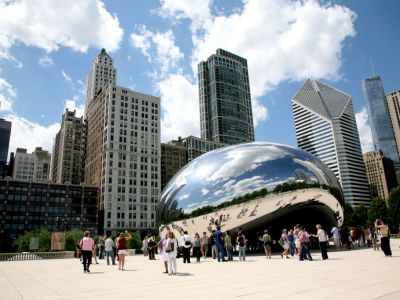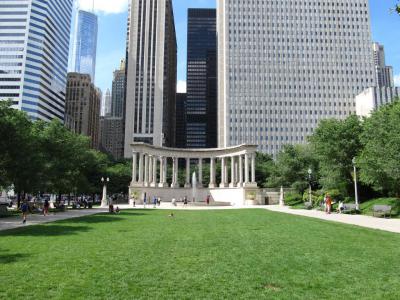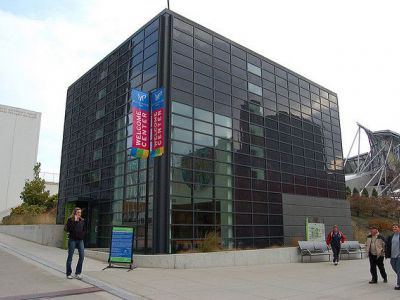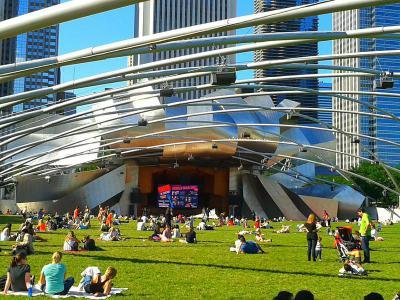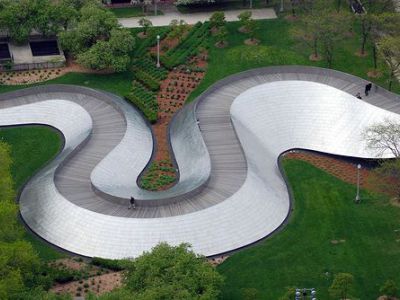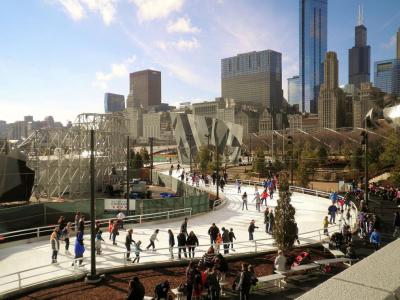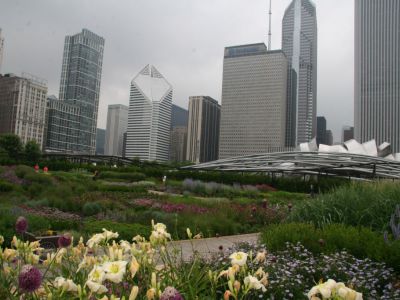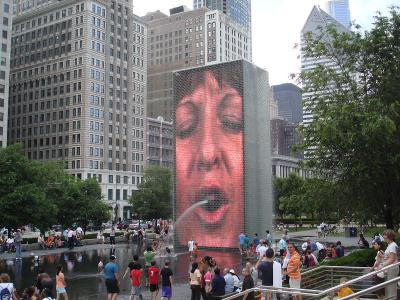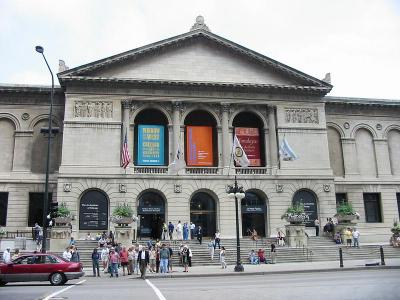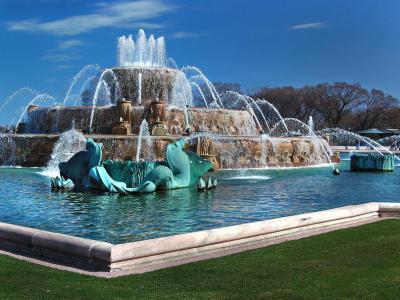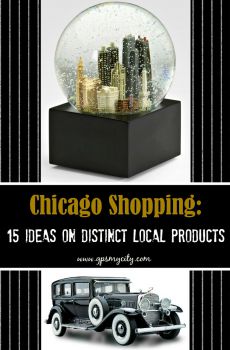Audio Guide: Millennium and Grant Parks Walking Tour (Self Guided), Chicago
If Chicago had a living room, it would be Grant Park - and if it had a shiny new media room, that would definitely be Millennium Park. These two sprawling green spaces hug the lakeshore like the city’s favorite blanket, offering locals and tourists alike a perfect blend of nature, art, and architecture with a side of skyline.
Let’s start with the elder of the two - Grant Park, established way back in 1844 when it was called Lake Park. It was renamed in 1901 to honor President Ulysses S. Grant, and soon became known as “Chicago’s front lawn.” And like any good front lawn, it hosts parties. We're talking Blues Fest, Taste of Chicago, Lollapalooza - this lawn surely knows how to throw down. It also houses cultural landmarks like the Art Institute of Chicago - one of the top art museums on the planet - and the ever-dramatic Clarence Buckingham Fountain, which puts on nightly water shows as if auditioning for a Vegas residency. Another key sight in the area, keeping the presidential theme strong, is a monument to Abraham Lincoln.
In 2004, part of the northern section of Grant Park was transformed into Millennium Park. There, you’ve got Cloud Gate, otherwise known as “The Bean,” the mirrored sculpture that reflects both the skyline and your awkward selfie face. Next to it, Wrigley Square and the Millennium Monument pay tribute to Chicago’s early do-gooders.
If you need to charge your car or just admire energy-efficient architecture, the Exelon Pavilions have you covered. The park’s crown jewel is the Jay Pritzker Pavilion, a metallic, wave-like concert stage that looks like it crash-landed from the future. Its architect, Frank Gehry, also designed the BP Pedestrian Bridge, a sleek walkway to Maggie Daley Park - a kid-friendly dreamland with climbing walls, ice skating, and probably a few scraped knees...
Millennium Park also chills things out with the Lurie Garden, a peaceful, flower-filled oasis, and turns things up again at the Crown Fountain, where digital faces spit water on delighted children (as well as the occasional unsuspecting adults).
Together, these parks reflect Chicago’s evolution from 19th-century neoclassical charm to 21st-century high-concept innovation - and they do it with style. So, if you're in the city, indulge your curious spirit and explore these dynamic landscapes firsthand - Chicago’s best front yard wide open.
Let’s start with the elder of the two - Grant Park, established way back in 1844 when it was called Lake Park. It was renamed in 1901 to honor President Ulysses S. Grant, and soon became known as “Chicago’s front lawn.” And like any good front lawn, it hosts parties. We're talking Blues Fest, Taste of Chicago, Lollapalooza - this lawn surely knows how to throw down. It also houses cultural landmarks like the Art Institute of Chicago - one of the top art museums on the planet - and the ever-dramatic Clarence Buckingham Fountain, which puts on nightly water shows as if auditioning for a Vegas residency. Another key sight in the area, keeping the presidential theme strong, is a monument to Abraham Lincoln.
In 2004, part of the northern section of Grant Park was transformed into Millennium Park. There, you’ve got Cloud Gate, otherwise known as “The Bean,” the mirrored sculpture that reflects both the skyline and your awkward selfie face. Next to it, Wrigley Square and the Millennium Monument pay tribute to Chicago’s early do-gooders.
If you need to charge your car or just admire energy-efficient architecture, the Exelon Pavilions have you covered. The park’s crown jewel is the Jay Pritzker Pavilion, a metallic, wave-like concert stage that looks like it crash-landed from the future. Its architect, Frank Gehry, also designed the BP Pedestrian Bridge, a sleek walkway to Maggie Daley Park - a kid-friendly dreamland with climbing walls, ice skating, and probably a few scraped knees...
Millennium Park also chills things out with the Lurie Garden, a peaceful, flower-filled oasis, and turns things up again at the Crown Fountain, where digital faces spit water on delighted children (as well as the occasional unsuspecting adults).
Together, these parks reflect Chicago’s evolution from 19th-century neoclassical charm to 21st-century high-concept innovation - and they do it with style. So, if you're in the city, indulge your curious spirit and explore these dynamic landscapes firsthand - Chicago’s best front yard wide open.
How it works: Download the app "GPSmyCity: Walks in 1K+ Cities" from Apple App Store or Google Play Store to your mobile phone or tablet. The app turns your mobile device into a personal tour guide and its built-in GPS navigation functions guide you from one tour stop to next. The app works offline, so no data plan is needed when traveling abroad.
Millennium and Grant Parks Walking Tour Map
Guide Name: Millennium and Grant Parks Walking Tour
Guide Location: USA » Chicago (See other walking tours in Chicago)
Guide Type: Self-guided Walking Tour (Sightseeing)
# of Attractions: 10
Tour Duration: 2 Hour(s)
Travel Distance: 2.7 Km or 1.7 Miles
Author: doris
Sight(s) Featured in This Guide:
Guide Location: USA » Chicago (See other walking tours in Chicago)
Guide Type: Self-guided Walking Tour (Sightseeing)
# of Attractions: 10
Tour Duration: 2 Hour(s)
Travel Distance: 2.7 Km or 1.7 Miles
Author: doris
Sight(s) Featured in This Guide:
- Cloud Gate
- Wrigley Square and Millennium Monument
- Exelon Pavilions
- Jay Pritzker Pavilion
- BP Pedestrian Bridge
- Maggie Daley Park
- Lurie Garden
- Crown Fountain
- Art Institute of Chicago
- Buckingham Fountain
1) Cloud Gate (must see)
At the shiny center of AT&T Plaza in Millennium Park, stands the Cloud Gate - or as Chicagoans lovingly call it, The Bean. Sculpted between 2004 and 2006 by Anish Kapoor, an Indian-born British artist known for making giant shiny things that you can’t help staring at, this was his first outdoor public piece in the United States-which quickly became the selfie magnet of the Midwest.
Made from over 160 stainless steel plates seamlessly fused together (so well, in fact, you'd swear it was magic), this mirror-like blob stretches 66 feet long, stands 33 feet tall, and weighs in at a casual 100 tons. It's shaped like a drop of liquid mercury but looks more like an alien lentil from a sleek future where everything is polished to perfection.
Now, here’s the kicker: when Kapoor first proposed it, the art world blinked. Some said, “Gorgeous idea,” others said, “Logistically impossible.” Welding it, polishing it, cleaning it would be a nightmare! And yet - they pulled it off, nonetheless, although not without a few delays. When Millennium Park opened in 2004, The Bean wasn’t quite ready for its big debut. It took until May 15, 2006, for the formal unveiling, and since then it’s been soaking up praise, Instagram filters, and about ten million fingerprints a year.
Now, if you leave Chicago without a photo warped in The Bean’s belly, some may wonder if you've ever been to Chicago at all... Indeed, it's reflective, massive, and playful - and frankly, it’s probably already seen your face in someone else's selfie...
Made from over 160 stainless steel plates seamlessly fused together (so well, in fact, you'd swear it was magic), this mirror-like blob stretches 66 feet long, stands 33 feet tall, and weighs in at a casual 100 tons. It's shaped like a drop of liquid mercury but looks more like an alien lentil from a sleek future where everything is polished to perfection.
Now, here’s the kicker: when Kapoor first proposed it, the art world blinked. Some said, “Gorgeous idea,” others said, “Logistically impossible.” Welding it, polishing it, cleaning it would be a nightmare! And yet - they pulled it off, nonetheless, although not without a few delays. When Millennium Park opened in 2004, The Bean wasn’t quite ready for its big debut. It took until May 15, 2006, for the formal unveiling, and since then it’s been soaking up praise, Instagram filters, and about ten million fingerprints a year.
Now, if you leave Chicago without a photo warped in The Bean’s belly, some may wonder if you've ever been to Chicago at all... Indeed, it's reflective, massive, and playful - and frankly, it’s probably already seen your face in someone else's selfie...
2) Wrigley Square and Millennium Monument
Tucked into the northwest corner of Millennium Park-right where Michigan Avenue gives Randolph Street a firm handshake-you’ll find Wrigley Square: a leafy, sun-soaked pocket of Chicago where art, architecture, and the occasional jazz riff come out to play. Think of it as the city’s elegant front porch: perfect for lounging on the lawn, snapping photos by the fountain, or casually pretending you stumbled into a cultural event like an art show or open-air photo exhibit. Sometimes, there's live music too.
At the heart of the square stands the Millennium Monument, showing off like it’s been there since ancient Athens. In reality, it's a near-full-scale replica of the original peristyle that graced this spot from 1917 to 1953-before it was dismantled to make room for a parking lot. Fortunately, eventually, artistic taste prevailed, and the peristyle returned, complete with its proud arc of 40-foot Doric columns made of limestone, thus giving serious gravitas to an already photogenic corner of town.
Look down at the base and you’ll see the stone-etched names of 122 donors-both individuals and companies-who made Millennium Park happen. In other words, the folks who helped turn downtown from drab to dazzling. In 2017, this classical beauty got a glow-up: LED lights that change color, sleek new paving stones, and polished concrete accents that make the whole fountain plaza sparkle like it just got back from a spa retreat.
So, next time you’re in the Loop, swing by Wrigley Square. It’s got shade, it’s got charm, and it doesn’t charge admission-unless you count the cost of falling a little bit more in love with Chicago...
At the heart of the square stands the Millennium Monument, showing off like it’s been there since ancient Athens. In reality, it's a near-full-scale replica of the original peristyle that graced this spot from 1917 to 1953-before it was dismantled to make room for a parking lot. Fortunately, eventually, artistic taste prevailed, and the peristyle returned, complete with its proud arc of 40-foot Doric columns made of limestone, thus giving serious gravitas to an already photogenic corner of town.
Look down at the base and you’ll see the stone-etched names of 122 donors-both individuals and companies-who made Millennium Park happen. In other words, the folks who helped turn downtown from drab to dazzling. In 2017, this classical beauty got a glow-up: LED lights that change color, sleek new paving stones, and polished concrete accents that make the whole fountain plaza sparkle like it just got back from a spa retreat.
So, next time you’re in the Loop, swing by Wrigley Square. It’s got shade, it’s got charm, and it doesn’t charge admission-unless you count the cost of falling a little bit more in love with Chicago...
3) Exelon Pavilions
The Exelon Pavilions - Millennium Park’s high-tech, energy-savvy little overachievers. Built in 2004 for a cool $7 million, these structures aren’t just pretty faces; they’re solar-powered machines that crank out enough juice each year to keep 16 energy-efficient homes happily humming along. Think of them as the park’s quiet green geniuses.
Up north, you've got two sleek black cubes - minimalist, moody, and very on-brand - designed to vibe with the neighboring Harris Theater for Music and Dance. That theater, by the way, was the brainchild of Thomas Beeby, a Driehaus Prize winner and all-around architecture rockstar. One of the cubes rolls out the welcome mat as the park’s official Welcome Center; the other acts as your stylish on-ramp to the underground parking garages. Bonus trivia is that both pavilions are the proud owners of the Midwest’s first electricity-generating curtain walls. Yes, walls that make power. The future is glassy...
Now heading south, things get a little sunnier - and a lot more Italian. Enter the two smaller Exelon Pavilions designed by Renzo Piano, the Italian architect whose notable works include the Centre Georges Pompidou in Paris, The Shard in London, and the Whitney Museum of American Art in New York City, to mention but a few. With their combo of clean limestone and crystal-clear glass, these buildings were crafted to play nice with the nearby Art Institute’s expansion plans. Pulitzer-winning architecture critic Blair Kamin gave this whole architect-led approach a standing ovation, calling it a stroke of brilliance. Had the job gone to an average contractor, he joked, we’d probably be stuck with bland utility boxes. Instead, we got something special...
Kamin called the southern pair “almost like little houses”-if your house happens to be a modernist masterpiece. His ultimate verdict-a solid 3 out of 4 stars. Not perfect, but in architecture terms, that’s practically a red carpet review...
Up north, you've got two sleek black cubes - minimalist, moody, and very on-brand - designed to vibe with the neighboring Harris Theater for Music and Dance. That theater, by the way, was the brainchild of Thomas Beeby, a Driehaus Prize winner and all-around architecture rockstar. One of the cubes rolls out the welcome mat as the park’s official Welcome Center; the other acts as your stylish on-ramp to the underground parking garages. Bonus trivia is that both pavilions are the proud owners of the Midwest’s first electricity-generating curtain walls. Yes, walls that make power. The future is glassy...
Now heading south, things get a little sunnier - and a lot more Italian. Enter the two smaller Exelon Pavilions designed by Renzo Piano, the Italian architect whose notable works include the Centre Georges Pompidou in Paris, The Shard in London, and the Whitney Museum of American Art in New York City, to mention but a few. With their combo of clean limestone and crystal-clear glass, these buildings were crafted to play nice with the nearby Art Institute’s expansion plans. Pulitzer-winning architecture critic Blair Kamin gave this whole architect-led approach a standing ovation, calling it a stroke of brilliance. Had the job gone to an average contractor, he joked, we’d probably be stuck with bland utility boxes. Instead, we got something special...
Kamin called the southern pair “almost like little houses”-if your house happens to be a modernist masterpiece. His ultimate verdict-a solid 3 out of 4 stars. Not perfect, but in architecture terms, that’s practically a red carpet review...
4) Jay Pritzker Pavilion
The Jay Pritzker Pavilion is Millennium Park’s central attraction. Designed by the ever-dramatic Frank Gehry (a Canadian-American architect known for his unconventional, dynamic designs that gained widespread attention in the 1970s and turned several of his buildings into landmarks), this open-air concert venue looks like a giant steel blossom mid-swoon, unfurling twelve shiny aluminum "ribbons" shooting up 120 feet (like a rockstar’s hair in zero gravity).
From below, it’s all elegance and surprise - a sunken stage cloaked in sculptural chaos, balanced by a massive steel trellis that drapes over the 4,000-seat amphitheater and spills into a grassy Great Lawn capable of holding up to 7,000 music-loving picnickers. That web overhead isn’t just for looks; it houses a state-of-the-art sound system designed to mimic the acoustics of a fancy indoor concert hall - the first of its kind in the U.S. Indeed, here, your ears are in for a treat, even if your seat is a patch of lawn.
During summer and early fall, the pavilion goes full throttle with free concerts. Expect everything from the refined swoon of the Grant Park Orchestra to foot-tapping jazz, global rhythms, and blues that might just melt your soft pretzel.
It’s not every day you get world-class acoustics, avant-garde architecture, a jumbo video screen, and clean restrooms all in one outdoor venue. As a bonus, most shows here are free, and people-watching is quite abundant.
Indeed, whether you're here for Beethoven or just the skyline selfies, the Pritzker Pavilion makes sure your experience hits all the right notes.
Pro tip:
Check out the event calendar in advance and, if you’re the punctual type, come early for the good spots. Sure, you could hover in the back park area, but the sound out there... Let’s just say it’s more "echo with wind" than "symphonic bliss."
From below, it’s all elegance and surprise - a sunken stage cloaked in sculptural chaos, balanced by a massive steel trellis that drapes over the 4,000-seat amphitheater and spills into a grassy Great Lawn capable of holding up to 7,000 music-loving picnickers. That web overhead isn’t just for looks; it houses a state-of-the-art sound system designed to mimic the acoustics of a fancy indoor concert hall - the first of its kind in the U.S. Indeed, here, your ears are in for a treat, even if your seat is a patch of lawn.
During summer and early fall, the pavilion goes full throttle with free concerts. Expect everything from the refined swoon of the Grant Park Orchestra to foot-tapping jazz, global rhythms, and blues that might just melt your soft pretzel.
It’s not every day you get world-class acoustics, avant-garde architecture, a jumbo video screen, and clean restrooms all in one outdoor venue. As a bonus, most shows here are free, and people-watching is quite abundant.
Indeed, whether you're here for Beethoven or just the skyline selfies, the Pritzker Pavilion makes sure your experience hits all the right notes.
Pro tip:
Check out the event calendar in advance and, if you’re the punctual type, come early for the good spots. Sure, you could hover in the back park area, but the sound out there... Let’s just say it’s more "echo with wind" than "symphonic bliss."
5) BP Pedestrian Bridge
Now, for a curvy little masterpiece courtesy of the same architect Frank Gehry, check out the BP Pedestrian Bridge. Not content with just designing the Jay Pritzker Pavilion, Gehry decided to go full serpentine with this sleek, stainless-steel footpath that twists its way across Columbus Drive. It connects Millennium Park to what used to be Daley Bicentennial Plaza - now known as Maggie Daley Park - and, as a bonus, it helps muffle the traffic noise so that concertgoers at the pavilion aren’t treated to a backup horn section from passing cars.
Before you start guessing, “BP” doesn’t stand for “Bicentennial Plaza.” Nope. It’s named after British Petroleum, who kindly chipped in $5 million to get this shiny 960-foot bridge built. So yes, it’s technically a corporate-sponsored snake - but a classy one.
Gehry didn’t have to fight for the job. He was the only architect considered and agreed to build the bridge after the Pritzker family nailed down the funding. As for the inspiration, it wasn't some high-tech CAD sketch either. Apparently, it came from a live carp his grandmother used to buy at the fish market. A fish. That’s right...
Indeed, apart from having a pretty face, this bridge is also a structural overachiever. Designed to carry heavy foot traffic without crumpling under its own stylish weight, it’s been praised for its innovative use of stainless steel, shaped into flowing, organic lines that scream "Gehry" without saying a word.
So, being here, walk it, because on a sunny day, this promises to be one of Chicago’s most scenic strolls. You get skyline views, peeks at Lake Michigan, and a graceful glide between Millennium Park and Maggie Daley Park. It’s part walkway, part sculpture - and entirely worth your steps.
Before you start guessing, “BP” doesn’t stand for “Bicentennial Plaza.” Nope. It’s named after British Petroleum, who kindly chipped in $5 million to get this shiny 960-foot bridge built. So yes, it’s technically a corporate-sponsored snake - but a classy one.
Gehry didn’t have to fight for the job. He was the only architect considered and agreed to build the bridge after the Pritzker family nailed down the funding. As for the inspiration, it wasn't some high-tech CAD sketch either. Apparently, it came from a live carp his grandmother used to buy at the fish market. A fish. That’s right...
Indeed, apart from having a pretty face, this bridge is also a structural overachiever. Designed to carry heavy foot traffic without crumpling under its own stylish weight, it’s been praised for its innovative use of stainless steel, shaped into flowing, organic lines that scream "Gehry" without saying a word.
So, being here, walk it, because on a sunny day, this promises to be one of Chicago’s most scenic strolls. You get skyline views, peeks at Lake Michigan, and a graceful glide between Millennium Park and Maggie Daley Park. It’s part walkway, part sculpture - and entirely worth your steps.
6) Maggie Daley Park
Maggie Daley Park is certainly not an average piece of greenery. This place is where a rolling landscape meets a playful imagination. The undulating terrain here creates a striking contrast to the neighboring Grant Park to the south, which keeps things prim and proper with its formal symmetry. Contrary to that, Maggie Daley breaks the mold with hills, curves, and meandering paths that feel more like a storybook than city grid. Moreover, this 27-acre wonderland has a secret: it’s all built atop a 4,000-car garage. Yep, those curious metal grates scattered across the lawns are none other than vintage 1970s air vents. So, basically, you’re strolling on Chicago’s most scenic green roof...
The heart of the park is a long, sloping “valley” stretching diagonally like it’s trying to escape to the lakefront. It’s a perfect spot for picnics, cloud-gazing, or pretending you’re in a shampoo commercial with the wind in your hair. This open expanse connects directly to the BP Pedestrian Bridge, so you can sashay in from Millennium Park with style. To the northwest, adrenaline gets its fix at the climbing wall and the skating ribbon - which ice skaters glide through in winter and scooter daredevils zoom around in summer. To the southeast, little adventurers get their own woodland kingdom in the kids’ play garden.
Nature and design flirt throughout the park - with massive tripod-style light masts standing tall like something out of a sci-fi forest. They’re meant to mimic moonlight, but currently, they look more like an "alien landing site." Maybe one day, when the trees grow taller, they’ll blend in a bit more.
The abundance of free activities - rock climbing, mini golf, skating, rolling, strolling - is richly complemented by the jaw-dropping views of Lake Michigan and the Chicago skyline from 40 feet up. It’s equal parts playground and postcard. So, go ahead. Wander. Climb. Glide. And try not to forget you're standing on a garage...
The heart of the park is a long, sloping “valley” stretching diagonally like it’s trying to escape to the lakefront. It’s a perfect spot for picnics, cloud-gazing, or pretending you’re in a shampoo commercial with the wind in your hair. This open expanse connects directly to the BP Pedestrian Bridge, so you can sashay in from Millennium Park with style. To the northwest, adrenaline gets its fix at the climbing wall and the skating ribbon - which ice skaters glide through in winter and scooter daredevils zoom around in summer. To the southeast, little adventurers get their own woodland kingdom in the kids’ play garden.
Nature and design flirt throughout the park - with massive tripod-style light masts standing tall like something out of a sci-fi forest. They’re meant to mimic moonlight, but currently, they look more like an "alien landing site." Maybe one day, when the trees grow taller, they’ll blend in a bit more.
The abundance of free activities - rock climbing, mini golf, skating, rolling, strolling - is richly complemented by the jaw-dropping views of Lake Michigan and the Chicago skyline from 40 feet up. It’s equal parts playground and postcard. So, go ahead. Wander. Climb. Glide. And try not to forget you're standing on a garage...
7) Lurie Garden
Just south of Millennium Park’s Great Lawn, where joggers trot and selfies happen on a near-industrial scale, lies something quieter-but no less ambitious: the Lurie Garden. Now, this isn’t your grandma’s flower patch. Clocking in at 2.5 acres, it tosses out the old 19th-century garden rules and instead goes full prairie chic-with over 130 native plant species doing their thing right in the middle of downtown Chicago.
Designed by a globe-trotting trio-Kathryn Gustafson from Seattle, Piet Oudolf from the Netherlands, and Robert Israel from L.A.-this living artwork features a dramatic 15-foot-tall “shoulder hedge.” This leafy wall is a tribute to Carl Sandburg’s poetic depiction of Chicago as the "stormy, husky, brawling, City of the Big Shoulders." A bonus here is the beautiful illumination at night...
Now, talking of its layout, there's a tidy boardwalk called The Seam slicing through the garden, tracing the ghost of old lakefront retaining walls. On one side, you’ve got the Dark Plate-moody, shady, and woodsy-while on the other: the Light Plate-sunny, breezy, full of perennials living their best life.
Curious souls can dive deeper on Sunday guided tours, running from mid-May to September. The tours leave every 15 minutes from the BP Bridge, starting at 10 am. It’s casual, it’s enlightening, and it doesn’t cost a dime.
This peaceful prairie hangout sandwiched between skyscrapers is officially recognized as the world’s largest green roof. Plus, it’s small enough not to wear out your feet-which, speaking of...
Pro tip:
That cool little stream running through the garden – yes, you can dip your feet in. Your toes will thank you.
Designed by a globe-trotting trio-Kathryn Gustafson from Seattle, Piet Oudolf from the Netherlands, and Robert Israel from L.A.-this living artwork features a dramatic 15-foot-tall “shoulder hedge.” This leafy wall is a tribute to Carl Sandburg’s poetic depiction of Chicago as the "stormy, husky, brawling, City of the Big Shoulders." A bonus here is the beautiful illumination at night...
Now, talking of its layout, there's a tidy boardwalk called The Seam slicing through the garden, tracing the ghost of old lakefront retaining walls. On one side, you’ve got the Dark Plate-moody, shady, and woodsy-while on the other: the Light Plate-sunny, breezy, full of perennials living their best life.
Curious souls can dive deeper on Sunday guided tours, running from mid-May to September. The tours leave every 15 minutes from the BP Bridge, starting at 10 am. It’s casual, it’s enlightening, and it doesn’t cost a dime.
This peaceful prairie hangout sandwiched between skyscrapers is officially recognized as the world’s largest green roof. Plus, it’s small enough not to wear out your feet-which, speaking of...
Pro tip:
That cool little stream running through the garden – yes, you can dip your feet in. Your toes will thank you.
8) Crown Fountain
Heading south of Tribune Plaza, brace yourself for one of Chicago’s quirkiest icons-Crown Fountain, the brainchild of Spanish artist Jaume Plensa. Picture this: two towering glass monoliths, each 50 feet tall, silently facing off across a slick granite plaza. What's more-they’ve got faces. Lots of them. Hidden LED screens light up with close-ups of 1,000 real Chicagoans, captured mid-expression as they pretend to blow on a feather. The result is giant digital heads pursing their lips until-surprise!-a stream of water shoots from their mouths, giving the illusion that the city itself is spitting with playful charm. It’s weird, it’s wonderful, and yes, kids love it.
In summer, the space turns into an urban splash zone where businesspeople, toddlers, and tourists alike lose all dignity and just run through it. During the colder months, it becomes more of a sculpture garden with a twist-silent faces glowing in the frosty air like the city’s own Greek chorus.
But the magic of Crown Fountain isn’t just in the waterworks. It’s in the momentary community it creates. Strangers grin at each other as they get soaked, couples sneak kisses under the spray, and parents take far too many blurry photos. For a few minutes, nobody cares where you're from-they’re just dodging a digital spit-take together.
Swinging by, there's a good chance you'll get all in one: sunshine, shade, splashing, sitting, and sipping coffee while watching humanity be its messy, joyful self. The water’s clean, the vibe’s warm, and the maintenance crew deserves a medal. This is public art at its most entertaining-and it’s free. So, go on, get misted...
In summer, the space turns into an urban splash zone where businesspeople, toddlers, and tourists alike lose all dignity and just run through it. During the colder months, it becomes more of a sculpture garden with a twist-silent faces glowing in the frosty air like the city’s own Greek chorus.
But the magic of Crown Fountain isn’t just in the waterworks. It’s in the momentary community it creates. Strangers grin at each other as they get soaked, couples sneak kisses under the spray, and parents take far too many blurry photos. For a few minutes, nobody cares where you're from-they’re just dodging a digital spit-take together.
Swinging by, there's a good chance you'll get all in one: sunshine, shade, splashing, sitting, and sipping coffee while watching humanity be its messy, joyful self. The water’s clean, the vibe’s warm, and the maintenance crew deserves a medal. This is public art at its most entertaining-and it’s free. So, go on, get misted...
9) Art Institute of Chicago (must see)
Climb the grand staircase, stride past the stone-faced lions who’ve seen it all, and step into the Midwest’s reigning heavyweight of art-The Art Institute of Chicago! Housed in a sprawling Beaux-Arts palace, this museum is practically an all-you-can-absorb buffet of global creativity. And just when you think you’ve got your bearings, bam-there’s the Modern Wing, sleek and gleaming like a spaceship, courtesy of the very same Renzo Piano.
Inside, the European Collection marches through history like a very well-dressed parade-from medieval saints to moody 1950s portraits, with Renaissance drama and Baroque flair in between. But the real crowd magnet is nearly 400 Impressionist and Post-Impressionist masterpieces. Monet, Van Gogh, Cézanne-they’re all here, casually hanging out like it’s no big deal. Over in the American wing, about 5,500 works stretch across centuries, from colonial portraits to early 20th-century boldness. And if you’re into decor with a past, the Terra Foundation’s loans serve up silver, ceramics, and furniture that could easily outclass anybody's grandma’s best set.
Also, don’t skip the local favorites: the pint-sized perfection of the Thorne Miniature Rooms (imagine dollhouses with Ivy League degrees), or Chagall’s “American Windows,” where stained glass sings in color.
Coming here, you're in for more than just a gallery stroll but a full-on, globe-spanning, time-traveling art adventure. From Greek gods to Japanese screens, African masks to Warhol prints, there’s something for every curious eye. And yes, the photography collection alone could fill a day. So, do come in, wander wide, and let the lions keep watch while you get your culture fix.
Inside, the European Collection marches through history like a very well-dressed parade-from medieval saints to moody 1950s portraits, with Renaissance drama and Baroque flair in between. But the real crowd magnet is nearly 400 Impressionist and Post-Impressionist masterpieces. Monet, Van Gogh, Cézanne-they’re all here, casually hanging out like it’s no big deal. Over in the American wing, about 5,500 works stretch across centuries, from colonial portraits to early 20th-century boldness. And if you’re into decor with a past, the Terra Foundation’s loans serve up silver, ceramics, and furniture that could easily outclass anybody's grandma’s best set.
Also, don’t skip the local favorites: the pint-sized perfection of the Thorne Miniature Rooms (imagine dollhouses with Ivy League degrees), or Chagall’s “American Windows,” where stained glass sings in color.
Coming here, you're in for more than just a gallery stroll but a full-on, globe-spanning, time-traveling art adventure. From Greek gods to Japanese screens, African masks to Warhol prints, there’s something for every curious eye. And yes, the photography collection alone could fill a day. So, do come in, wander wide, and let the lions keep watch while you get your culture fix.
10) Buckingham Fountain (must see)
Right in the thick of Chicago’s downtown grid, amid suits and skyscrapers, you’ll find Grant Park showing off its true showstopper: one of the largest fountains in the world! And no, it's not just there to impress tourists. This aquatic giant was a lavish gift from Kate Sturges Buckingham, a 20th-century American art collector and philanthropist, who had some serious cash to splash thanks to her family's grain empire. She dedicated it to her brother, with whom she shared a deep love for art (and apparently, dramatic gestures).
What you get is less “sprinkler system” and more “sculptural fever dream.” Imagine a three-tiered marble wedding cake dressed in pink seashells, ringed with gleeful fish spraying water like it’s going out of style, and four bronze sea horses rearing back in dramatic flair - each repping one of the states touching Lake Michigan. It all came together in 1927, channeling Versailles vibes, only bigger. Because this is Chicago...
Now, if you want the full Buckingham Fountain experience, show up between May and October. That’s when the real magic happens - hourly water shows with lights that shimmer and shift like the fountain’s throwing its own rave. Stick around long enough, and you'll see the center jet shooting 150 feet into the air like it’s trying to signal the moon.
Tip break:
While here, don’t just stare at the spray. Head west across Columbus Drive and give a nod to the quietly dignified Lincoln statue - seated, reflective, and looking like he’s contemplating the next big speech. Sculpted by Augustus Saint-Gaudens in 1926, it’s the introvert to the fountain’s extrovert. Then swing by Congress Parkway near Michigan Avenue, where The Bowman and the Spearman strike a pose. These towering bronze Indian warriors aren’t just decorative-they're 17 feet of pure stoic intensity.
What you get is less “sprinkler system” and more “sculptural fever dream.” Imagine a three-tiered marble wedding cake dressed in pink seashells, ringed with gleeful fish spraying water like it’s going out of style, and four bronze sea horses rearing back in dramatic flair - each repping one of the states touching Lake Michigan. It all came together in 1927, channeling Versailles vibes, only bigger. Because this is Chicago...
Now, if you want the full Buckingham Fountain experience, show up between May and October. That’s when the real magic happens - hourly water shows with lights that shimmer and shift like the fountain’s throwing its own rave. Stick around long enough, and you'll see the center jet shooting 150 feet into the air like it’s trying to signal the moon.
Tip break:
While here, don’t just stare at the spray. Head west across Columbus Drive and give a nod to the quietly dignified Lincoln statue - seated, reflective, and looking like he’s contemplating the next big speech. Sculpted by Augustus Saint-Gaudens in 1926, it’s the introvert to the fountain’s extrovert. Then swing by Congress Parkway near Michigan Avenue, where The Bowman and the Spearman strike a pose. These towering bronze Indian warriors aren’t just decorative-they're 17 feet of pure stoic intensity.
Walking Tours in Chicago, Illinois
Create Your Own Walk in Chicago
Creating your own self-guided walk in Chicago is easy and fun. Choose the city attractions that you want to see and a walk route map will be created just for you. You can even set your hotel as the start point of the walk.
Chicago Chinatown Walking Tour
Tucked away just south of the Loop, the Chinatown of Chicago was established in 1912 and is considered one of the best examples of American Chinatown. While it may be one of Chicago’s smallest neighborhoods geographically, it is big on character, colors, sights, sounds, and flavors. Here, you’ll find a wide range of unique boutiques, specialty shops, religious sights, authentic Chinese... view more
Tour Duration: 1 Hour(s)
Travel Distance: 1.7 Km or 1.1 Miles
Tour Duration: 1 Hour(s)
Travel Distance: 1.7 Km or 1.1 Miles
The Magnificent Mile Walking Tour
The stretch of Michigan Avenue from the Chicago River to Lake Shore Drive, otherwise known as the Magnificent Mile, is regarded as one of the world’s great avenues – or Chicago’s version of Fifth Avenue. Take this self-guided walk to explore its whole stretch and surrounding area, featuring a wide selection of amazing stores/malls, world-known museums, restaurants and spectacular... view more
Tour Duration: 3 Hour(s)
Travel Distance: 4.0 Km or 2.5 Miles
Tour Duration: 3 Hour(s)
Travel Distance: 4.0 Km or 2.5 Miles
Chicago Introduction Walking Tour
Chicago, perched on the shores of Lake Michigan in Illinois, is a city steeped in history and urban vibrancy. Known by numerous nicknames such as the Windy City and the City of Big Shoulders, it boasts a skyline marked by towering structures. The area of today's Chicago, initially inhabited by Native American tribes, saw its first European-settled reference as "Chicagou" in 1679, a... view more
Tour Duration: 2 Hour(s)
Travel Distance: 3.9 Km or 2.4 Miles
Tour Duration: 2 Hour(s)
Travel Distance: 3.9 Km or 2.4 Miles
Chicago Old Town Walking Tour
Settled in 1850 by German immigrants, Chicago’s Old Town neighborhood is a popular destination for locals and visitors who cater to the entertainment venues, restaurants, pubs, coffee shops and boutiques – all of which have turned an area once referred to as the “Cabbage Patch” into an attraction that rivals Navy Pier, Wrigley Field and the Magnificent Mile.
Start your Old Town walking... view more
Tour Duration: 2 Hour(s)
Travel Distance: 2.6 Km or 1.6 Miles
Start your Old Town walking... view more
Tour Duration: 2 Hour(s)
Travel Distance: 2.6 Km or 1.6 Miles
Chicago Navy Pier Walking Tour
Additional to scenic views of the lake, the boats, and the city skyline, the Navy Pier offers a variety of attractions on the waterfront – for kids as well as adults – that draw nearly ten million people annually, making this Chicago's most visited spot. Yes, some may see it as a “tourist trap”, but it is worth the time and money to spend some time here, so take this self-guided walk... view more
Tour Duration: 1 Hour(s)
Travel Distance: 1.0 Km or 0.6 Miles
Tour Duration: 1 Hour(s)
Travel Distance: 1.0 Km or 0.6 Miles
Loop District Architecture Walking Tour
The Chicago Loop District-essentially the city’s historic downtown-has long been a stage for architectural innovation and an open-air museum of American architecture.
The construction boom started after the Great Chicago Fire of 1871, which destroyed much of the central business district, gave architects a blank canvas to rebuild the city from the ground up. What followed was a surge of... view more
Tour Duration: 3 Hour(s)
Travel Distance: 4.7 Km or 2.9 Miles
The construction boom started after the Great Chicago Fire of 1871, which destroyed much of the central business district, gave architects a blank canvas to rebuild the city from the ground up. What followed was a surge of... view more
Tour Duration: 3 Hour(s)
Travel Distance: 4.7 Km or 2.9 Miles
Useful Travel Guides for Planning Your Trip
Chicago Souvenirs: 15 Distinct Local Products to Bring Home
One of the most fascinating cities in the U.S., if not the whole world, Chicago has no shortage of things closely associated with it, often due to their direct origin (blues, gangstership, etc.), so one might literally be spoiled for choice as to what to choose as a "piece" of Chicago to...
The Most Popular Cities
/ view all



